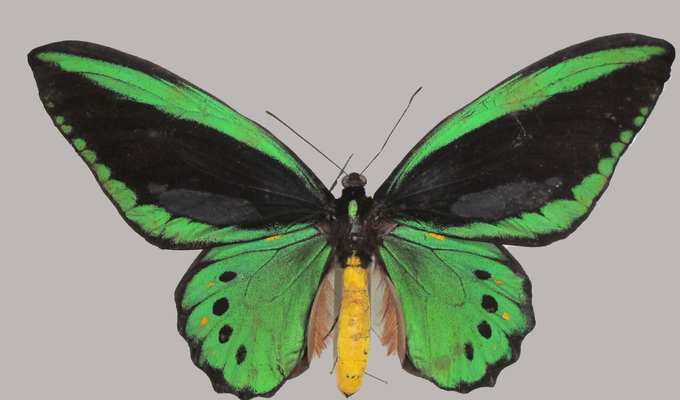The foundation of this sub-collection was laid in the early 20th century, when the National Museum acquired the first large collections of butterflies from František Antonín Nickerl, his son, Otakar Nickerl the older, from Napoleon Manuel Kheil, and later from other renowned entomologists, particularly Arnošt Silbernagel and Otto Holik. Gradually, tens of small and bigger butterfly collections were added, the latest large additions being the scientifically valuable collections of Bohumil Vančura and Kristián Krušek.
The butterfly sub-collection is currently arranged in three basic levels.
- (1) The smaller share of the collection material is organized systematically (nowadays marked as the basic collection) and stored in older 40x50x6 cm entomology boxes. The boxes have a complete lid with another glass lid underneath. The organization of the taxonomic collection, the level of identification and the formal requirements (e.g. the labelling of individual species in the boxes, the marking of boxes, etc.) corresponds to the time in which the basic collection was created, which was around the 1950s. In later years, new material was added to some parts of the collection. In total, however, these additions were not large. With regard to individual groups, greatest attention was paid to “day-time” butterflies from the Palearctic. Only some of the other groups of large moths were organized systematically; some, not at all. To this day, the micromoths section remains unprocessed (except for several small families).
- (2) Presently, the second level consists of possibly the largest section of collection material. It includes collections of individual pieces, which are stored in their original state; so far, they have not been sorted out and included in the basic collection due to insufficient space in the previous workplace of the department. The collection material is stored in original boxes, largely of non-standard sizes, and the quality of organization and the correctness of identification corresponds to the professional level and personal care of the original owners.
- (3) The third level consists of unsorted material. This includes mostly species of tropical butterflies (sometimes without location labels), which were in the past taken out of the historical collection and only very loosely divided into two groups: Active in the day-time and active in the night-time. This arrangement was meant to be the first step of future systematic arrangement; unfortunately, the next steps never followed. Intensive work with this material started only in 2015, while currently some of the collection material has finally been placed in the basic collection. Besides these three levels, we must mention the rather large amount of study material, which is continuously being added to through the activities of the department’s staff, for example during work trips. However, this material is continuously identified and arranged taxonomically, which raises it to level 2 material.
In total, the butterfly sub-collection includes approximately 1 million preserved specimens, stored in about seven thousand boxes. In addition to valuable fauna material (primarily species that are extinct in their traditional locations), the butterfly sub-collection contains several hundred type specimens from almost all groups. The processing of the voluminous type material relating to Zigaena, described by Otto Holik in the mid-20th century, and several dozen species of moths collected by Kristián Krušek, should be mentioned as being particularly valuable.

